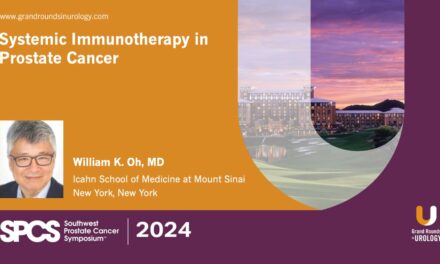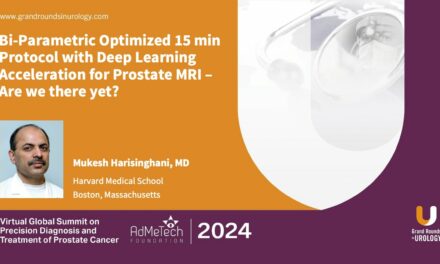Seth K. Bechis, MD, presented “Point-Counterpoint: Holmium vs. Thulium Laser – Holmium” during the 30th Annual Perspectives in Urology: Point-Counterpoint, on March 10, 2023, at Humphreys Half Moon Inn, San Diego, California.
How to cite: Bechis, Seth K. “Point-Counterpoint: Holmium vs. Thulium Laser – Holmium.” March 10, 2023. Accessed Jun 2025. https://grandroundsinurology.com/point-counterpoint-holmium-vs-thulium-laser-holmium/
Point-Counterpoint: Holmium vs. Thulium Laser – Holmium – Summary
Seth K. Bechis, MD, discusses concerns with thulium fiber lasers (TFLs) and highlights holmium laser capabilities and their benefits. He opens by reviewing laser procedure terminology and noting the holmium laser’s increased reliability in comparison to TFL. Dr. Bechis analyzes misconceptions of TFL frequency capabilities and examines the pulse features of holmium lasers. He highlights pulse modulation in holmium lasers, a feature that allows urologists to reduce retropulsion.
He continues by examining the short and long pulse settings of holmium lasers, emphasizing that issues associated with short pulse fire, such as retropulsion and fiber degradation, can be solved with long pulse. Dr. Bechis discusses the variety offered by holmium lasers and eases concerns associated with the holmium laser’s special circuit requirements. He reviews MOSES pulsed laser modulation and similar technology.
He also explores different stone treatment methods, including fragmenting, dusting, and popcorning. Dr. Bechis stresses the significance of popcorning, noting that the holmium laser surpasses TFL in this technique and provides the retropulsion level necessary for effective fragmentation. He then reviews advantages and disadvantages of dusting, fragmenting, and popcorning, leading to a discussion on whether dusting or fragmenting is preferable in stone treatment.
After reviewing multiple studies, including a study from the EDGE Research Consortium, Dr. Bechis notes that there is no clear winner between dusting and fragmenting and pinpoints caveats to the literature on the subject. He then analyzes thermal injury concerns with TFL. Dr. Bechis concludes with a focus on the holmium laser’s ability to maximize efficient power and minimize heat, explaining TFL’s relative inefficiency and additional heat concerns.
This lecture is part of a Point-Counterpoint debate. Its opposing lecture is “Point-Counterpoint: Holmium vs. Thulium Laser – Thulium.”
About the 30th Annual Perspectives in Urology: Point Counterpoint conference: Presented by Program Chair and Grand Rounds in Urology Editor-in-Chief E. David Crawford, MD, this conference brought together leading experts in urology, medical oncology, and radiation oncology to discuss and debate the latest topics in genitourinary cancers, primarily prostate cancer and bladder cancer. This interactive conference offered topical lectures, pro/con debates, interesting-case presentations, interactive panel discussions, and interactive audience and faculty networking.
ABOUT THE AUTHOR
Seth K. Bechis, MD is a board-certified urologist specializing in diseases of the urinary tract, including kidney stones, benign prostatic hyperplasia (BPH) or enlarged prostate, and men's health issues. Dr. Bechis completed fellowship training in laparoscopy/robotics and endourology at the University of California (UC), San Diego School of Medicine, and residency training at Harvard Medical School, Massachusetts General Hospital in Boston. He earned his medical degree from UC San Francisco School of Medicine and holds additional Master of Science training in biomedical research, also from UC San Francisco, focusing on ways to prevent and treat diseases.
As a member of the Comprehensive Kidney Stone Center at UC San Diego Health, Dr. Bechis has a special interest in advanced surgical treatment, medical prevention, and research on kidney stone disease. He has surgical expertise in percutaneous nephrolithotomy (PCNL) for complex stones, ureteroscopy, and shockwave lithotripsy. Dr. Bechis specializes in all procedures of the prostate including minimally invasive procedures such as Rezum water vapor therapy and UroLift, as well as robotic surgery and GreenLight™ Laser photoselective vaporization of the prostate (PVP).
Dr. Bechis serves as the associate program director for the UC San Diego - Kaiser Laparoscopy/Endourology Fellowship in the Department of Urology at UC San Diego School of Medicine. His current research includes improving surgical techniques and clinical outcomes in stone disease, as well as tools for stone diagnosis and opiate-sparing pathways for managing pain. His research has been featured in peer-reviewed medical journals and he has authored chapters for university handbooks.
Prior to joining UC San Diego Health, Dr. Bechis worked at Massachusetts General Hospital and Harvard Medical School, where he taught residents and medical students in the operating room and clinic.




